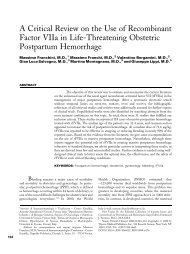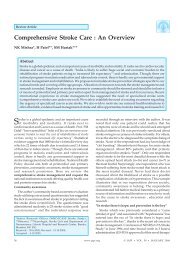Acquired isolated factor VII deficiency associated with severe ...
Acquired isolated factor VII deficiency associated with severe ...
Acquired isolated factor VII deficiency associated with severe ...
You also want an ePaper? Increase the reach of your titles
YUMPU automatically turns print PDFs into web optimized ePapers that Google loves.
350 Blood Coagulation and Fibrinolysis 2004, Vol 15 No 4<br />
Table 2<br />
Prior reports of <strong>isolated</strong> acquired <strong>factor</strong> <strong>VII</strong> <strong>deficiency</strong><br />
Author, year Age (years), sex Comorbidity F<strong>VII</strong>:C (%) Mixing study pattern Bleeding Therapy, comments<br />
Slease and Shumacher, NS Hodgkin lymphoma NS NS Yes Chemotherapy, <strong>with</strong> resolution<br />
1977 [1]<br />
Campbell et al., 1980 [2] 66, male Lung carcinoma 30 Inhibitor Nil No treatment<br />
Delmer et al., 1989 [3,5] 62, male Nil known 11 Inhibitor Gut, urinary, biliary,<br />
intracranial<br />
IVIG, cyclophosphamide,<br />
corticosteroids, apheresis,<br />
azathioprin<br />
Ndimbie et al., 1989 [4] 37, male AIDS 14 Inhibitor Nil No treatment<br />
Weisdorf et al., 1989 [6] 18, female Aplastic anaemia 16 Deficiency Intracranial BMT; corticosteroids for GVHD<br />
resulted in correction of F<strong>VII</strong> level<br />
Mehta et al., 1992 [7] NS Penicillin NS NS Fatal bleeding NS<br />
de Raucort et al., 1994 [8] 30, male Pleural liposarcoma 15 Inhibitor Nil IVIG, FFP; response <strong>with</strong><br />
chemotherapy, then relapse <strong>with</strong><br />
tumour recurrence<br />
Biron et al., 1997 [9] Multiple Sepsis 30 Deficiency Yes 11 cases <strong>with</strong> mild ‘heterozygouslike’<br />
F<strong>VII</strong> <strong>deficiency</strong> <strong>associated</strong> <strong>with</strong><br />
sepsis<br />
Brunod et al., 1998 [10] 60, male Orchitis 12 Inhibitor Gastric FFP, F<strong>VII</strong> concentrate,<br />
corticosteroids<br />
Muleo et al., 1998 [11] 36, male Hepatic lymphoma<br />
<strong>with</strong> abnormal LFTs<br />
10 Deficiency None 10 mg/kg rF<strong>VII</strong>a pre liver biopsy,<br />
and at 6 and 12 h post biopsy<br />
White et al., 1999 [13] Male Acute leukaemia,<br />
35 Deficiency Haemoptysis rF<strong>VII</strong>a<br />
Aspergillus infection<br />
Okajima and colleagues,<br />
2000 [12,18]<br />
66, male Nil , 1 Inhibitor Gut, urinary Corticosteroids<br />
Toor et al., 2002 [14] 7–43,<br />
4 female,<br />
4 male<br />
BMT (6 allogeneic,<br />
2 autologous)<br />
Aguilar et al., 2003 [15] 80, male Chronic lung disease,<br />
TCC bladder<br />
8–35<br />
(mean 22)<br />
Deficiency<br />
Frequent major<br />
bleeding<br />
38 Inhibitor Cutaneous, soft tissue,<br />
gut<br />
Lupus anticoagulants present in four<br />
patients; poor outcome no response<br />
to FFP and fatal bleeding in two<br />
patients<br />
Tranexamic acid, corticosteroids<br />
AIDS, <strong>Acquired</strong> immune <strong>deficiency</strong> syndrome; BMT, bone marrow transplantation; F<strong>VII</strong>:C, <strong>factor</strong> <strong>VII</strong> coagulant activity; GVHD, graft versus host disease; IVIG,<br />
intravenous immunoglobulin; LFTs, liver function tests; NS, not stated; TCC, transitional cell carcinoma.<br />
case [6,9,11,13]. Few reports have attempted to formally<br />
demonstrate the presence of an inhibitor [5,6,18].<br />
Weisdorf et al. [6] reported the case of an 18-year-old<br />
female <strong>with</strong> aplastic anaemia and profound F<strong>VII</strong> <strong>deficiency</strong>,<br />
eventually corrected <strong>with</strong> bone marrow transplantation.<br />
As in our case, there was no evidence of an<br />
inhibitor on mixing studies. The authors found that<br />
significantly more F<strong>VII</strong>:C activity was removed after<br />
incubation <strong>with</strong> protein A sepharose in comparison <strong>with</strong><br />
a normal control, suggesting the presence of an IgG<br />
inhibitor accelerating F<strong>VII</strong> clearance, but not inhibiting<br />
F<strong>VII</strong>:C activity [6]. We repeated this experiment, but<br />
found much higher post : pre PGS treatment F<strong>VII</strong>:C<br />
ratios than Weisdorf et al., <strong>with</strong> only a mild reduction in<br />
activity that was comparable between patient and<br />
control. The experiment was performed three times<br />
and, although the standard deviation was high, this was<br />
comparable <strong>with</strong> that of Weisdorf, indicating that this<br />
technique gives variable results. It is thus likely that<br />
the plasma F<strong>VII</strong> activity measured in the untreated<br />
samples reflects F<strong>VII</strong> circulating in unbound form. No<br />
evidence could be found for F<strong>VII</strong> retaining coagulant<br />
activity but bound in a complex <strong>with</strong> anti-F<strong>VII</strong> IgG (as<br />
hypothesized by Weisdorf et al.). Likewise, no evidence<br />
of inhibitory activity could be detected in a modified<br />
Bethesda assay using patient plasma and purified IgG.<br />
If there is no evidence of an inhibitor in these experiments,<br />
what is the pathogenesis of the <strong>severe</strong> F<strong>VII</strong><br />
<strong>deficiency</strong> in this case? It remains possible that an<br />
inhibitor was responsible, but not present in excess and<br />
rapidly cleared after binding F<strong>VII</strong>, as previously suggested<br />
[6]. This would explain the <strong>deficiency</strong> pattern in<br />
mixing studies, the lack of inhibitory activity in the<br />
Bethesda assay, and the lack of differential F<strong>VII</strong>:C<br />
activity after PGS incubation. In other reports of<br />
acquired F<strong>VII</strong> <strong>deficiency</strong> in the context of sepsis, F<strong>VII</strong>cleaving<br />
proteases liberated by pathogens or granulocytes<br />
have been postulated [9,13]. Of note, F<strong>VII</strong>:C<br />
levels were substantially higher in cases thought to be<br />
protease-related (rather than inhibitor related) than in<br />
this case. Furthermore, this hypothesis is speculative,<br />
and the liberation of proteases has not been formally<br />
demonstrated in previous reports.<br />
The recovery of F<strong>VII</strong>a (as measured by F<strong>VII</strong>:C assay)<br />
also provides insights into the mechanism of F<strong>VII</strong><br />
<strong>deficiency</strong>. The recovery of rF<strong>VII</strong>a was comparable<br />
<strong>with</strong> previous reports [19,20] and <strong>with</strong> recovery in<br />
patients <strong>with</strong> inherited F<strong>VII</strong> <strong>deficiency</strong> that we have<br />
treated <strong>with</strong> rF<strong>VII</strong>a (unpublished data). In vivo recovery<br />
(IVR) was also calculated by the methods of<br />
Nilsson and Hedner [21] (mean IVR, 14.6%; standard<br />
deviation, 4.5) and Prowse [22] (mean IVR, 0.38 U/dl<br />
per U/kg; standard deviation, 0.11). These results are<br />
comparable <strong>with</strong> published rF<strong>VII</strong>a IVR data in inherited<br />
F<strong>VII</strong> <strong>deficiency</strong> [23]; however, the half-life in our<br />
Copyright © Lippincott Williams & Wilkins. Unauthorized reproduction of this article is prohibited.





